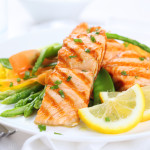MEATS & FISH
Marbled beef, pork, bacon, sausage, and other pork products; fatty fowl (duck, goose); skin
and fat of turkey and chicken; processed meats; luncheon meats (salami, bologna); hot dogs
and fast-food hamburgers (they’re loaded with fat); organ meats (kidneys, liver); canned fish
packed in oil.
EGGS Limit egg yolks to two per week.
FRUITS Coconuts (rich in saturated fats).
VEGETABLES Starchy vegetables (potatoes, corn, lima beans, dried peas. beans) may be used only if
substitutes for a serving of bread or cereal. (Baked potato skin, however, is desirable for its
fiber content.)
BEAN’S Commercial baked beans with sugar and or pork added.
NUTS Limit peanuts. Walnuts and almonds are more preferable type nuts.
BREADS & GRAINS Any baked goods with shortening and/or sugar. Commercial mixes with dried eggs and
whole milk. Avoid sweet rolls, doughnuts, breakfast pastries (Danish). and sweetened
packaged cereals (the added sugar converts readily to triglycerides).
MILK PRODUCTS Whole milk and whole milk packaged goods; cream; ice cream: whole-milk puddings,
yogurt, or cheeses; nondairy cream substitutes.
FATS & OILS Butter, lard, animal fats, bacon drippings, gravies, cream sauces as well as palm and coconut
oils. All these are high in saturated fats. Examine labels on “cholesterol free-products for
hydrogenated fats” (These are oils that have been hardened into solids and in the process
have become saturated.)
DESSERTS Fried snack foods like potato chips; chocolate; candies in general; jams; jellies;
SNACKS syrups; whole-milk puddings; ice cream and milk sherbets; hydrogenated peanut butter.
BEVERAGES Sugared fruit juices and soft drinks; cocoa made with whole milk and or sugar. When using
alcohol (1/2 oz liquor, 12 oz beer, 5 oz dry table wine per serving “), one serving may be
substituted for one bread or cereal serving (limit: two servings of alcohol per day).
SPECIAL NOTES
- Remember that even non-limited foods should be used in moderation.
- While on a cholesterol-lowering diet, be sure to avoid animal fats and marbled meats.
- While on a triglyceride lowering diet, be sure to avoid sweets and to control the amount of carbohydrates you eat (starchy foods such as flour, bread, and potatoes). Buy a good low-fat cookbook, such as the one published by the American Heart Association.
- Consult your physician if you have any questions.
GUIDELINES FOR LOW CHOLESTEROL, LOW-TRIGLYCERIDE DIETS
FOODS TO USE
MEAT & FISH Choose lean meats (chicken, turkey, veal, and nonfatty cuts of beef with excess fat trimmed;
one serving = 3 oz of cooked meat). Also, fresh or frozen fish, canned fish packed in water,
and shellfish (lobster, crabs, shrimp, oysters). Limit use to no more than one sensing of one
of these per week. Shellfish are high in cholesterol but low in saturated fat and should be
used sparingly. Meats and fish should be broiled (pan or oven) or baked on a rack.
EGGS Egg substitutes and egg whites (use freely). Egg yolks (limit two per week).
FRUITS Eat three servings of fresh fruit per day (1 serving = ½ cup). Be sure to have at least one
citrus fruit daily. Frozen or canned fruit with no sugar or syrup added may be used.
VEGETABLES Most vegetables are not limited (see reverse side). One dark green (string beans, escarole) or
one deep yellow (squash) vegetable is recommended daily. Cauliflower, broccoli, and
celery, as well as potato skins are recommended for their fiber content. (Fiber is associated
with cholesterol reduction.) It is preferable to steam vegetables, but they may be boiled,
strained, or braised with polyunsaturated vegetable oil (see below).
BEANS Dried peas or beans (1 serving = ½ cup) may be used as a bread substitute.
NUTS Almonds, walnuts, and peanuts may be used sparingly (1 serving = 1 tablespoonful). Use
pumpkin, sesame, or sunflower seeds.
BREAD & GRAINS One roll or one slice of whole grain or enriched bread may be used, or three soda crackers
or four pieces of melba toast as a substitute. Spaghetti, rice or noodles (½ cup) or ½ large
ear of corn may be used as a bread substitute. In preparing these foods, do not use butter or
shortening, use soft margarine. Also use egg and sugar substitutes. Choose high fiber grains,
such as oats and whole wheat.
CEREALS Use ½ cup of hot cereal or ¾ cup of cold cereal per day. Add a sugar substitute if desired,
with 99% fat-free or skim milk.
MILK PRODUCTS Always use 99% fat free or skim milk, dairy products such as low fat cheeses (farmer’s,
uncreamed diet cottage), low fat yogurt, and powdered skim milk.
FATS & OILS Use soft (not stick) margarine; vegetable oils that are high in polyunsaturated fats (such as
safflower, sunflower, soybean, corn, and cottonseed). Always refrigerate meat drippings to
harden the fat and remove it before preparing gravies.
DESSERT Limit to two servings per day; substitute each serving for a bread/cereal serving: ice milk,
& SNACKS water sherbet (¼ cup); unflavored gelatin or gelatin flavored with sugar substitute (1/3
cup); pudding prepared with skim milk (½ cup); egg white souffles: unbuttered popcorn (1
1/2 cups). Substitute carob for chocolate.
BEVERAGES Fresh fruit juices (limit 4 oz per day); black coffee, plain or herbal teas; soft drinks with
sugar substitutes; club soda, preferably salt free; cocoa made with skim milk; or nonfat dried
milk and water (sugar substitute added if desired); clear broth. Alcohol: limit two servings
per day (see reverse side).
MISCELLANEOUS You may use the following freely: vinegar, spices, herbs, nonfat bouillon, mustard.
Worcestershire sauce, soy sauce, flavoring essence.
You may have been advised to you lower your triglyceride levels. While medication and aerobic exercise are effective in triglyceride lowering, there are also several dietary approaches you can try. If you want to lower your triglycerides without medications, be sure you talk with your doctor so that you can work together.
Here’s Why It Is Important to Decrease Your Triglyceride Levels:
Triglycerides are the form in which most fat exists in food as well as in the body. In addition to consuming triglycerides in food, our bodies can make triglycerides from carbohydrate. Excess calories (those not used right away by the body’s tissues) are converted to triglycerides and transported to fat cells to be stored. These stored triglycerides can be broken down when the body needs energy.
Recent research has linked a high triglyceride level (called hypertriglyceridemia) to an increased risk of heart disease. High and normal triglyceride levels are defined as follows:
- Less than 150 milligrams/deciliter (mg/dl [1.7 mmol/L] = normal
- 150-199 mg/dl (1.7-2.2 mmol/L) = borderline high
- 200-499 mg/dl (2.3-5.6 mmol/L) = high
- 500 mg/dl and above (5.7 mmol/L) = very high
Here’s How To Do It:
If your triglyceride level is above 150 mg/dl (1.7 mmol/L), the following steps can help you lower your level to the healthful range:
Eat a Diet Low in Saturated Fat
All heart-healthy diets are low in saturated fat. Saturated fat is found in full-fat dairy products (whole milk, cream, butter, cheese, ice cream), meats, lard, fried foods, coconut palm, and palm kernel oils. Replace these foods with healthier fats and whole grain carbohydrates.
Eat More Unsaturated Fats
These healthy fats include monounsaturated and polyunsaturated fats. These fats are found in canola oil, olive oil, nuts, avocados, olives, and fatty fish. Fatty fish, such as mackerel, trout, albacore tuna, and salmon, are especially good choices because they are rich in omega-3 fatty acids. These fats are good for your heart and may also help prevent other chronic conditions. Research has shown that eaten regularly, they can reduce your triglyceride level.
Some ideas for replacing saturated fat with unsaturated fat include the following:
- Choose fish over beef when dining out.
- At the barbecue, go for grilled tuna steak instead of a hamburger or hot dog.
- Put lox (smoked salmon) on your bagel instead of butter.
- Cook with olive oil instead of butter.
- Put slices of avocado in your sandwich instead of cheese.
- Snack on nuts and dried fruit instead of potato chips.
Cut Down on Simple Carbohydrates (Sugar)
While it is important to reduce saturated fat, do not overly restrict total fat (aim for less than 25–35% of total calories from fat). Excess carbohydrate can actually raise your triglycerides, while lowering HDL cholesterol, which is the “good” kind of cholesterol. This is why the recommendation is to replace saturated fat with healthier unsaturated fat. Also, limit sugary foods such as candy, soda, and sweets. Choose whole grain carbohydrates, such as whole wheat bread and brown rice.
Lose Excess Weight
Often losing as little as a 5-10 pounds can help lower your triglyceride level. To lose weight, cut down on excess calories from all sources, not just fat. Combine this decreased intake with a regular exercise program to increase the amount of calories you burn.
Limit Alcohol Intake
Alcohol may contribute to high triglyceride levels. Consider drinking alcohol in moderation. Moderate alcohol consumption is one drink per day for women and up to two drinks per day for men.
Stop Smoking
Smoking is a major risk factor for heart disease. If you smoke, talk to your doctor about ways to quit.
Exercise Regularly
The American Heart Association recommends being physically active for 150 minutes of moderate exercise per week.
If you are not physically active already, you can start with 10 minutes of moderate activity like walking, swimming, or yoga, and gradually increase your activity. Talk to your doctor before starting an exercise program.





